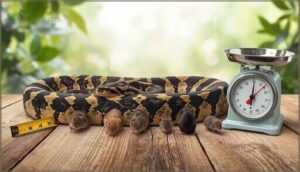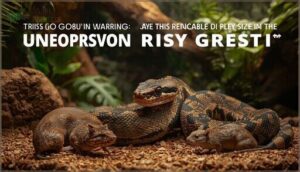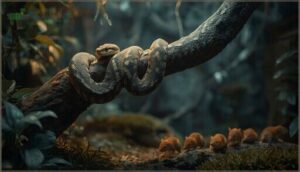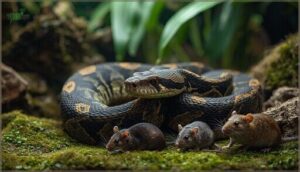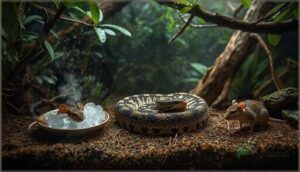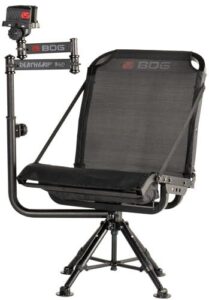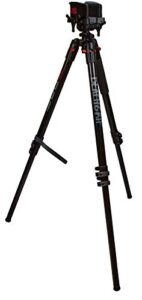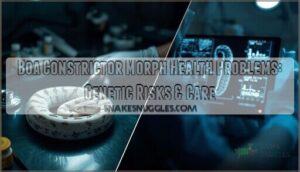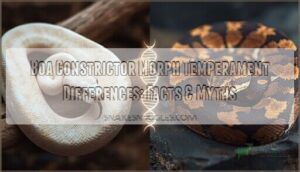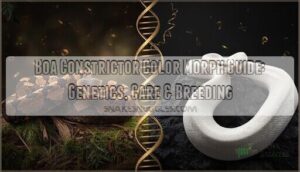This site is supported by our readers. We may earn a commission, at no cost to you, if you purchase through links.

A boa constrictor’s dinner isn’t just a meal—it’s a key to its long-term health and growth. Put the wrong prey in front of your snake, and you might deal with more than a grumpy boa: think regurgitation, stunted growth, or even dangerous health issues. But get it right, and you set the stage for a thriving, active pet that sheds and grows on schedule.
Mastering how to choose boa constrictor prey is about more than grabbing the first mouse you see; it’s about making every meal count, from size and type to timing and safety.
Table Of Contents
- Key Takeaways
- Key Factors in Choosing Boa Prey
- Ideal Prey Types for Boa Constrictors
- Determining Proper Prey Size
- Feeding Schedules and Frequency
- Health Considerations When Selecting Prey
- Live Vs. Frozen-Thawed Prey Choices
- Top 5 Products for Safe Boa Feeding
- Frequently Asked Questions (FAQs)
- What do boa constrictors eat?
- Do boa constrictors eat rats?
- Are boa constrictors carnivores?
- Do boa constrictors eat chickens?
- Can a boa constrictor eat a rabbit?
- Are boa constrictors predators?
- Can prey carry diseases harmful to boa constrictors?
- What signs indicate a boa refuses new prey?
- How to store frozen prey for maximum freshness?
- Are supplements needed with captive diets?
- Conclusion
Key Takeaways
- Always match prey size to your boa’s thickest body point, keeping prey weight under 10% of the snake’s body for safe feeding.
- Rotate between rodents, birds, and occasionally small mammals to provide balanced nutrition and mimic natural diet variety.
- Adjust feeding frequency and prey size based on your boa’s age, growth stage, and seasonal changes to avoid obesity or underfeeding.
- Choose frozen-thawed prey over live options whenever possible to reduce injury risk, improve hygiene, and enable safer supplementation.
Key Factors in Choosing Boa Prey
Picking the right prey for your boa constrictor isn’t just about what’s handy—it’s about what’s healthy. There are a few key factors to keep in mind when choosing what goes on the menu. Here’s what really matters as you decide.
Age and Size of The Boa
Ask any boa, and it’ll tell you: Age and size rule the dinner table. As your boa grows, you’ll need to adjust prey size and feeding plans:
- Neonates thrive on tiny prey, often pink rats.
- Juvenile scaling means slowly increasing meal size.
- Subadult volume and adult proportion focus on fitting prey to metabolism rates.
To promote proper health, monitor feeding frequency based on their body condition.
Natural Dietary Preferences
What a boa constrictor eats in the wild depends on habitat prey selection and what’s on the menu—mice, birds, even reptiles. Each wild prey type brings its own nutritional value. Juveniles lean on lizards, while adults hunt more mammals.
Matching a boa constrictor’s diet to these natural preferences keeps them thriving, supporting dietary health impact and strong, steady growth.
Frequency of Feeding
Matching natural dietary preferences is only half the puzzle; feeding frequency matters just as much. Age-based intervals shape how often you offer food—young snakes eat more frequently, while adults benefit from a longer waiting time between feedings. A boa’s feeding frequency depends on age and size.
Keep in mind, digestion time, seasonal effects, and growth effects all play into feeding schedule adjustments and help avoid obesity risks in your boa.
Ideal Prey Types for Boa Constrictors
Choosing the right food for your boa keeps it healthy and happy. There are a few types of prey that stand out as smart, reliable options. Here’s what you should know before feeding time rolls around.
Rodents (Mice, Rats)
Ever notice how rodents do the heavy lifting in your boa’s diet? With excellent rodent nutritional value and predictable prey size stages, mice and rats tick every box. Stick to prey size guidelines—nothing wider than your snake’s thickest point.
Frozenthawed rodents win for safety and convenience. Remember, proper prey selection and feeding frequency keep digestion smooth and health on track.
Birds and Small Mammals
With avian prey and small mammals in your lineup, you add key diversity and nutritional balance. In the wild, boas target prey variety—think tree-roosting birds and elusive bats. When planning mammal selection or bird type, keep these essentials in mind:
- Prey diversity encourages hunting behavior instincts
- Each prey type offers unique nutrients
- Mind your prey size every time
Prey Variety for Balanced Nutrition
Although keeping things simple might sound tempting, providing your boa with varied prey for balanced diet aids nutrient absorption and digestive efficiency. Think of prey rotation as insurance against deficiency risks, adjusted for seasonal needs and every prey type you offer.
Here’s how variety matters:
| Prey Type | Key Benefit |
|---|---|
| Rodents | Energy, protein |
| Birds/Lizards | Calcium, vitamins |
Determining Proper Prey Size
Getting prey size right keeps your boa healthy and stress-free. It isn’t just about what looks good; there are clear rules to follow.
Here’s what you need to know before choosing the next meal.
Weight and Width Guidelines
Think of selecting prey for your boa constrictor like picking just the right-sized shoe for a child—neither too loose nor tight. Proper prey weight and prey width reduce regurgitation risks and feeding stress.
For healthy boa constrictor feeding, always:
- Make sure prey matches width of the thickest part.
- Keep prey weight under 10% of snake’s body.
- Choose types of prey for boas by size categories.
Prey-to-Boa Size Ratio
Getting prey size right is about precision, not guesswork. Girth vs. Mass matters: most keepers match prey width to the boa’s thickest point, but mass percentage guidelines—like 10% for hatchlings or less for adults—help fine-tune.
Age specificity and frequency impact growth. Reliable sizing benchmarks simplify how you measure prey and tailor your boa constrictor diet through every growth stage.
Risks of Oversized or Undersized Prey
Feeding your boa prey that’s too large is asking for trouble—regurgitation risks, intestinal impaction, and even respiratory strain all climb fast. Oversized meals lead to regurgitation or serious blockages, while undersized prey means underfeeding, poor growth effects, and weak body condition.
Feeding your boa prey that’s too large or too small risks regurgitation, health problems, and impaired growth
Sharp prey size guidelines keep feeding efficiency high and help your snake avoid the pitfalls of overfeeding or underfeeding.
Feeding Schedules and Frequency
Figuring out how often to feed your boa can feel like a puzzle at first. Every snake’s schedule is different, depending on age and even the time of year.
Let’s look at what to expect so you can keep your boa healthy and thriving.
Hatchlings Vs. Juveniles Vs. Adults
Ever notice how your boa’s age sets the whole table? Hatchling prey is bite-sized—pinkies or fuzzies—suited for feeding baby boa constrictors every 7–10 days. As juvenile boas grow, their diet shifts to hoppers or small birds, with juvenile diet and adult portions spaced further apart. For adult boas, feeding schedule and digestion rates slow—but smart prey size still rules.
- Hatchlings: weekly meals, small rodents; prey size for hatchlings and juveniles kept under 10% body weight.
- Juvenile boas: larger juvenile diet variety, meals every 5–7 days, hoppers or chicks.
- Adults: adult portions once every 10–14 days, prey size for adult boa constrictors aligned with body width.
Adjusting for Growth and Season
As your boa grows, so does its appetite—and not just in a straight line. Age adjustments and seasonal metabolism shifts matter: cooler temps slow everything down.
That’s why feeding frequency and prey size need tweaks as temperatures change and growth rate shifts. Pay close attention to individual variation; some boas prefer a slower feeding schedule during seasonal variations in prey availability.
Monitoring Digestion Time
When you tap into the digestion process, you unlock the secret language of your snake’s metabolism. Watch for these clues:
- Fecal Passage marks full digestion.
- Thermoregulation Impact: warmer temps mean speedier digestion.
- Gut Remodeling resets post-meal.
- Refeeding Intervals depend on digestion time.
- Track Metabolic Rate—never rush a meal; each snake’s diet moves at its own rhythm.
Health Considerations When Selecting Prey
Choosing the right prey does more than just fill your boa’s belly. It can make a real difference in their health and growth.
Here’s what you’ll want to keep in mind before picking their next meal.
Nutritional Value and Supplementation
When you’re sizing up prey, nutritional requirements should guide your choices. Rodent vitamin deficiencies—especially low calcium and Vitamin D3—call for careful attention to the Calcium-Phosphorus Ratio. If rodents are the main diet, consider calcium supplementation or vitamin D supplements.
Gut-loading prey boosts micronutrients, but beware: too much supplementation can cause toxicity risks and disrupt natural balances in your snake.
Signs of Overfeeding or Underfeeding
If calcium balance matters, so does reading your boa’s body shape. Fat rolls near the head, lethargy signs, or even regurgitation risks point to overfeeding in a boa constrictor diet. Noticeable spine visibility or prowling behavior signals underfeeding and calls for quick adjustment in feeding habits.
- Fat rolls mean time to scale back meals
- Spine visibility warns of underfeeding
- Lethargy, regurgitation show your boa’s body condition
Tracking Body Condition and Growth
Tracking body condition and growth keeps your snake healthy and on target. Growth monitoring isn’t just about numbers—condition indices and a feeding log reveal how feeding regime and prey size affect results. Spotting obesity signs or slow growth early prevents issues down the road. Here’s a look at practical growth tracking for captive boas:
| Metric | How Often? | Why Track? |
|---|---|---|
| Weight | Monthly | Checks growth rate |
| Snout–vent length | Monthly | Monitors body length |
| Body condition | Regularly | Flags obesity signs |
| Prey size offered | Every meal | Ensures safe feeding |
| Feeding log | Ongoing | Captures regime data |
Live Vs. Frozen-Thawed Prey Choices
Choosing between live and frozen-thawed prey is a decision every boa keeper faces. Each option comes with its own set of challenges and benefits.
Let’s look at what you should know before picking what’s best for your snake.
Safety and Convenience
Ever wondered why so many keepers reach for frozen-thawed prey? Bite risk drops, rodents become easier to store (hello, frozen storage), and you can easily offer supplement injection. Monitoring behavior is simpler, too. A sanitary environment means less stress. When you follow feeding guidelines, ethical feeding and the right prey size keep both you and your boa safe.
| Live Prey Concerns | Frozen-Thawed Benefits |
|---|---|
| Bite risk | Reduces injuries |
| Sanitation issues | Keeps environment clean |
| Hard to supplement | Supplements via injection |
Nutritional Comparison
Regarding boa constrictor diet, understanding the nutritional tug-of-war between live vs. frozen prey, rodent vs. avian choices, and prey variety can make all the difference. Whole prey items support essential reptile nutrition, but freeze-thaw cycles may lower some vitamins over time. Balancing age/sex differences helps prevent nutrient deficiencies and meets your boa’s nutritional requirements.
| Factor | Live Prey | Frozen-Thawed |
|---|---|---|
| Protein/Fat | Comparable | Comparable |
| Micronutrients | Intact | Slightly Lower |
| Safety | Lower | Higher |
| Storage Ease | Low | High |
| Prey Variety | Moderate | High |
Transitioning to Frozen-Thawed Prey
Curious how to coax your boa into accepting frozen-thawed prey? It often comes down to scent enhancement, consistent thawing protocols, and knowing when to switch tactics. Using warmed, well-prepared prey boosts acceptance rates and safety outcomes.
Frozen-thawed prey yields big logistical benefits—easy storage, fewer feeding problems, and better hygiene. Check the table below for quick comparisons:
| Strategy | Result |
|---|---|
| Proper thawing | Higher acceptance rates |
| Scent enhancement | Minimizes feeding stress |
| Safe handling | Fewer injuries risk |
| Long-term storage | Logistic efficiency |
Top 5 Products for Safe Boa Feeding
When feeding your boa safely, the right gear can make all the difference. Practical tools can protect both you and your snake while streamlining the process.
Here are some top products to help make feeding time a breeze.
1. Ginsco Camo Ghillie Suit Set
When you’re fine-tuning your feeding setup, a camo suit might seem like a strange ally—but the Ginsco Camo Ghillie Suit Set stands out for field camouflage and comfort.
Made from lightweight polyester mesh for excellent material breathability, it lets you blend into brush without overheating. Sizing adjustability means layering over your hunting gear isn’t a hassle, though gloves may run large.
Durability considerations matter, since boa constrictor diet checks and prey selection often require trekking into thick terrain for safe, precise feeding.
Best For: Hunters, wildlife photographers, and outdoor enthusiasts needing lightweight, breathable camouflage in woodland or brush environments.
- Light, breathable polyester mesh helps keep you cool during long periods in the field.
- Complete 5-piece set (jacket, pants, hood, gloves, mask, storage bag) offers full-body coverage and is easy to pack.
- Adjustable fit allows for wearing over regular clothes and extra mobility.
- Durability is mixed, with some reports of easy tearing and thin material.
- Gloves and pants sizing can be unreliable, often running too large or too short.
- Not suitable for cold conditions or heavy-duty use due to lightweight construction.
2. Allen Company Vanish Camo Balaclava
Looking for real camo effectiveness in the field? The Allen Company Vanish Camo Balaclava brings that and then some. Its polyester construction gives you material durability and breathability features hunters crave—important if you’re selecting frozen-thawed prey or evaluating prey size outdoors.
Flexible uses? Wear it as a full mask or gaiter. User ratings average 4.5 stars, pointing to reliability even during routine boa constrictor diet or prey selection checks. Comfort, practicality, and concealment, all in one tool.
Best For: Hunters, outdoor enthusiasts, and motorcyclists who need reliable all-season camouflage and breathability in the field.
- Versatile full-face coverage with breathable mesh keeps you comfortable during long hours outdoors.
- Realtree Edge camo pattern helps you blend in with woodland environments, boosting concealment success.
- Stretches to fit most adults and can be worn as a full mask or neck gaiter for different activities.
- May not provide enough warmth in very cold conditions.
- Bright white interior fabric can show if the mask shifts out of place.
- Fit may be loose on smaller head sizes.
3. BOG DeathGrip 360 Hunting Chair
You want Chair Stability and real Hunting Ergonomics when prepping boa constrictors’ prey in the field—BOG’s DeathGrip 360 Hunting Chair nails both. Its solid powder-coated frame and wide, pivot-ready seat keep you comfortable and steady on uneven ground, even when sorting prey size or logging feeding events.
The durable fabric withstands wet, messy work without quitting. When it’s time to move, Portability Factors like the fast-folding frame and carry strap mean you won’t fumble safety for convenience—ideal for safe, efficient feeding.
Best For: Hunters who need a rock-solid seat with great portability and quiet rotation, especially in tough or uneven terrain.
- Extremely stable with individually adjustable legs and a silent 360-degree pivot—won’t spook wildlife.
- Built tough with steel and durable fabric that resists weather, water, and long-term wear.
- Folds up quick and packs easily with an integrated strap, fitting most backcountry needs.
- At 23 pounds, it’s heavier than many lightweight hunting chairs.
- Can tip if the gun is clamped in and you stand up too quickly—requires some caution.
- Needs occasional maintenance (lubrication, adjustments) to stay silent and smooth.
4. The Hunt 4K Ultra HD
Now, let’s talk about The Hunt 4K Ultra HD—this tool lifts your snake-keeping game with unparalleled 4K Accuracy. When you’re studying boa constrictor feeding, every detail counts: high-definition visuals bring prey size, hunting methods, and subtle behaviors into sharp focus. You spot what lower resolutions miss.
Educators and hobbyists both benefit, as footage offers real Behavioral Insights and boosts learner recall. Its inclusion in major Scientific Publications and strong Market Influence say plenty. Why guess, when you can see for yourself?
Best For: Wildlife researchers, educators, and hobbyists who want to analyze boa constrictor feeding behavior in vivid, scientifically accurate 4K detail.
- Stunning 4K visuals reveal micro-movements and hunting strategies often missed in standard HD.
- Enhances scientific accuracy and educational engagement, with proven boosts to learner recall and interest.
- Widely cited in research, trusted by academics, and featured in top wildlife streaming charts.
- Some scenes may be too dark, requiring screen brightness adjustments for best clarity.
- Content is limited to English audio and may not suit all ages due to mature themes.
- Not ideal for viewers seeking traditional or less intense natural history documentaries.
5. BOG DeathGrip Aluminum Shooting Tripod
After you’ve analyzed sharp 4K footage, it pays to use sturdy equipment that makes all your measuring tasks easier. The BOG DeathGrip Aluminum Shooting Tripod brings Tripod Stability and aluminum durability right to your workspace.
You’ll appreciate hands-free operation—whether weighing prey, noting types of prey for boa constrictors, or measuring prey size against boa constrictor size.
With smart adjustment features and proven field performance, this tripod lets you focus on accuracy, not wobble, so every safe feeding decision stands on a solid platform.
Best For: Hunters, shooters, or wildlife researchers who need a rock-solid, easy-to-adjust tripod for stable rifle, crossbow, or equipment support in the field.
- Built from heavy-duty aluminum for lasting durability in rough outdoor use.
- Adjustable legs, 360° panning head, and quick locks let you set up fast and adapt to any shooting or viewing angle.
- Excellent hands-free stability, even in wind or on uneven ground, so you can focus on precision.
- Heavier than carbon fiber tripods, which can make carrying over long distances tiring.
- Leg locks may feel tight at first and need some breaking in.
- A shoulder strap isn’t included, so carrying options are limited out of the box.
Frequently Asked Questions (FAQs)
What do boa constrictors eat?
Boa constrictors are opportunistic eaters—wild prey ranges from rodents and birds to lizards and even monkeys.
In captivity, their diet focuses on prey animals like rats, mice, chicks, and small mammals, adjusted to their size and age.
Do boa constrictors eat rats?
Rats feature prominently in the Boa constrictor diet in both the wild and captivity. Captive rat feeding is common due to their balanced Rat Nutritional Value, but prey size matters. Live Rat Risks mean frozen options are safest.
Are boa constrictors carnivores?
Across dozens of habitats, studies show their diet composition includes only animal prey—76 vertebrate species in one review.
This strict dietary classification means boa constrictors are obligate carnivores with diverse prey habits and essential ecological roles.
Do boa constrictors eat chickens?
Chickens are fair game for boa constrictors, both in the wild and when kept in captivity. Chicken Nutritional Value stacks up well against rodents, but practical observations show feeding risks—pay close attention to prey size and monitor digestion.
Can a boa constrictor eat a rabbit?
Think of boa constrictors as the top diners at nature’s feast—yes, they can eat rabbits.
But you’ll want to mind size limitations, rabbit nutrition, digestion risks, and feeding frequency when sourcing prey to match your boa’s needs.
Are boa constrictors predators?
Boa constrictors are top predators—true masters of their habitats. They use clever hunting strategies and unique predation adaptations, targeting a wide dietary breadth.
Their hunting and carnivorous diet have big ecological impacts, controlling prey populations and maintaining balance.
Can prey carry diseases harmful to boa constrictors?
Prey-borne pathogens are a real threat for your snake, whether you use live or frozen prey. Rodents especially can transmit internal parasites or dangerous bacteria.
Safe sourcing and careful handling are essential for disease prevention and snake health.
What signs indicate a boa refuses new prey?
Like a picky diner at a buffet, your snake may show Strike Refusal, Retreat Behavior, or Snout Bumping the prey.
Defensive Posture or Scent Rejection often signal the boa constrictor’s reluctance, revealing an uninterested feeding response.
How to store frozen prey for maximum freshness?
Store frozen prey at −18°C in airtight packaging to prevent freezer burn. Use a dedicated freezer, label by date, and keep it segregated from human food.
For best frozen prey nutrition, follow safe thawing protocols and hygiene practices.
Are supplements needed with captive diets?
You may need calcium supplements or vitamin D3 if your boa lacks UVB lighting, or if prey quality is uncertain.
Watch for over-supplementation, since vitamin deficiencies or excess can cause health problems. Supplement choices and needs vary.
Conclusion
A boa’s next meal is more than nourishment—it’s the decisive move in a living game of chess. Each prey item you choose, sized just right, tips the board toward health or setback.
Mastering how to choose boa constrictor prey isn’t about luck; it’s about reading the board, learning patterns, and setting your snake up for long-term checkmate.
When every feeding is intentional, you discover a future where your boa grows steady, strong, and right on schedule.
- https://www.herpconbio.org/Volume_18/Issue_3/Henderson_2023.pdf
- https://nre.tas.gov.au/Documents/Boa-constrictor-risk-assessment.pdf
- https://darrenhamillreptiles.com/boa-constrictor-husbandry/
- https://www.animalsathome.ca/boa-constrictor-feeding-chart/
- https://www.boa-constrictors.com/en/interesting_facts_about_boa_constrictor/boa_constrictor_care/feeding_boa_constrictor/proper_size_prey_specialized_feeders


